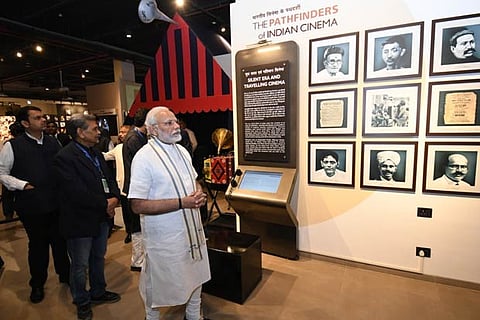

Mumbai
"How's the josh," the PM asked the audience "Uri" style as he inaugurated India's first National Museum of Indian Cinema (NMIC) here. He said without the viewers even realising it, films change their thinking process, as movies and society are "reflections" of each other.
"Films are identified with social changes... They have the knack to catch the future developments. Films help integrate our people who speak hundreds of different languages and thousands of dialects, the vastly diverse cultures, boost tourism in a big way and help generate employment opportunities, thus contributing immensely to the nation-building process," Modi said.
Moreover, he pointed out that Indian films represent the country around the world, show a ‘mirror' to the people outside, help improve our image globally, with our films, music, songs, stars creating a long-lasting impact in many countries.
"Films also create hopes and aspirations among the people all over the country... Now, youngsters hailing from smaller towns or Tier II-III cities are emerging in a big way and creating waves in the film industry. Our strength is now coming out of such small places. This is a sign of changing times and society, problems are being portrayed along with solutions, obstacles are being removed, millions problems have billion solutions. We are not overawed by problems, but work to resolve them... That's the determination of New India," Modi said.
He said that besides films, even Indian television serials like "Kyunki Saas Bhi Kabhi Bahu Thi" and "Ramayan" among many others are becoming very popular abroad where people have a desire for a glimpse of the common Indian's life.
Besides, he said films with social messages like the need for toilets can catch the popular imagination and many filmmakers are already making a conscious effort in this direction, plus science and development, integrating films and theatre and other aspects of modern times.
The PM assured the government's full support to strengthen the film industry, set up a university for films and entertainment, tweaking laws to tackle the challenges encountered by filmmakers including piracy, and the future of digital and social media vis-a-vis films.
Earlier, he inaugurated the NMIC in the presence of a galaxy of past and present Bollywood personalities like Manoj Kumar, Aamir Khan, A.R. Rahman, Asha Bhosle, Pandit Shivkumar Sharma, Randhir Kapoor, Karan Johar, Madhur Bhandarkar, Kiran Shantaram, Boney Kapoor, David Dhawan, Rohit Shetty, Waheeda Rehman, Jeetendra Kapoor, Asha Parekh, Pankaj Kapoor, Rakeysh Omprakash Mehra, Parineeti Chopra, Divya Dutta, and many others in attendance.
Maharashtra Governor C.V. Rao, Chief Minister Devendra Fadnavis, union ministers Rajyavardhan Singh Rathore, Ramdas Athawale, Shyam Benegal, Prasoon Joshi and other dignitaries were also present on the occasion.
'Glimpse into 105-year film history'
Set up at a cost of Rs 140 crore, the NMIC will help viewers understand the glorious history of Indian films and help film students, filmmakers, fans and critics learn and understand about cinema as a medium of artistic expression in the country and globally.
The museum displays a collection of rare artefacts like vintage cameras, projectors, old and new editing and recording equipments, costumes, photographs and other materials since the dawn of Indian cinema in 1913 with the first full-length feature film "Raja Harishchandra" made by the legendary Dhundiraj Govind Phadke, known as Dadasaheb Phalke.
There are also film sets, props, film tapes, sound tracks, trailers, transparencies, and a rich collection of film-related literature and memorabilia depicting Indian film history in a chronological order.
The NMIC's Children's Film Studio offers visitors an opportunity to explore the science, technology and art of film-making, hands-on experience on various facets associated with making cinema like cameras, lights, shooting, experience of acting -- presented in an interactive format.
The exhibits displayed include chroma studio, immersive experience zone, stop-motion animation studio, virtual makeover studio and more.
Designed by the National Council of Science Museums, it was first envisaged in 1997, and set up in the 19th century heritage bungalow, Gulshan Mahal and in another adjacent modern five-storied building, spread across 12,000 sq metres, in the heart of south Mumbai.
The new building has four exhibition halls, including one which shows "Gandhi & Cinema" which features not only the movies made on Mahatma Gandhi, but also showcases the deep impact his life had on cinema.
The museum comprises more than three dozen interactive galleries devoted to cinema and its journey from the silent era to talkies, black-and-white to colour, from the celluloid films era to digital technology and a children's activity gallery.
It is divided into 9 sections comprising "The Origin of Cinema", "Cinema comes to India", "Indian Silent Film", "Advent of Sound", "The Studio Era", "The impact of World War II", "Creative Resonance", "New Wave and Beyond" and "Regional Cinema".
The NMIC project was undertaken by the state-owned Navratna public sector undertaking, NBCC (India) Ltd, and is a delightful treat for historians, tourists and film buffs from all over the world thronging the country's film headquarters.
NBCC Chairman and Managing Director Anoop Kumar Mittal said that the entire NMIC complex is a "film hub" narrating the rich history of Indian cinema in the heart of south Mumbai.
The unique design features include a unique front elevation designed with inclined structural glazing support by cable nets with spiders and a glass façade to provide a 3D view impression to the structure, said Mittal.
The complex includes a multipurpose hall for movie previews, social events, conferences or seminars and cultural gatherings, besides incorporating several features to make it green and eco-friendly.\
Visit news.dtnext.in to explore our interactive epaper!
Download the DT Next app for more exciting features!
Click here for iOS
Click here for Android